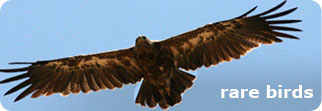|
|
 |
|
Home / Birds and Nature /
Dalmatian Pelican
Amvrakikos: In the lagoons of the Dalmatian Pelicans
Description & DistributionThe islets situated in the lagoons Tsoukalio and Logari of Amvrakikos Bay host the colonies of one of the world's rarest bird species: the Dalmatian Pelican (Pelecanus crispus).
In former times the Dalmatian Pelican occurred widely in Europe (as far as Hungary) and Asia. In the last one hundred years, however, its population dropped drastically and its occurrence in Europe is now limited to a few Balcan wetlands. The main reason accountable for this shrinking is land reclamation for the purpose of farming and hunting in the wetlands. Today, 13% of the couples of Dalmatian Pelicans in the world occur in two Greek regions: the lake of Mikri Prespa in the department of Florina and the lagoons of Amvrakikos Bay. Biology & BehaviourDalmatian Pelicans are afraid of people, therefore they nest in inaccessible areas such as isolated islets or inaccessible reed beds. Being fish-eaters, they choose wetlands that can ensure abundant food for their chicks. In Amvrakikos, the breeding season lasts from mid-January to July. In the beginning, the birds converge on the islets in the lagoons for mating. They build their nests with grass and twigs and begin to lay eggs in mid-February. They lay two eggs in each nest (rarely three) which they brood for 31 days by covering them with their feet webs and not with their bellies. The hatchlings are born naked but are covered with white feathers in one-month time. Until the age of two and a half months they depend totally on their parents. Both parents take turns in feeding their chicks in a very special manner: chicks plunge their heads avidly in their parents' bills and eat the half-digested food (fish) directly from within the pouch. By mid-August even the younger chicks tried flying following adult birds in their local flights. Dalmatian Pelicans spend winter in Amvrakikos because of mild weather conditions and abundance of food. By contrast, they abandon the lake of Mikri Prespa due to the severe cold. Hazards & Threats
To keep nesting in Amvrakikos Bay, Dalmatian pelicans need a source of abundant food. In recent years, massive death of fish has been repeatedly observed in the lagoons due to changes in the quality of water, mainly lack of oxygen. These alterations are related to human activities in surrounding areas and they threaten not only the Dalmatian pelicans but also fish fauna and the human communities that earn their living from fish. What we can do to protect Dalmatian PelicansThe Dalmatian pelican is protected by Greek legislation and by international conventions that forbid hunting and disturbance in general particularly in breeding areas (Directive 79/409/EEC). However, our own involvement is necessary for their protection. Therefore:
Text - Photographs: D. Hatzilakou |
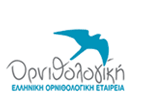
|
|
Personal Data Protection Policy Copyright © 2024 Hellenic Ornithological SocietyThemistokleous 80, GR-10681, Athens, Greece, Tel/Fax: +30 210 8227937, +30 210 8228704, e-mail: info@ornithologiki.gr Fragkon 22, GR-54625, Thessaloniki, Greece Tel/ Fax: +30 2310 244245, e-mail: thess@ornithologiki.gr |
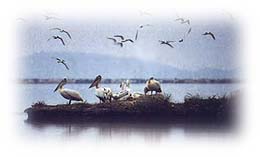 The Dalmatian Pelican is the rarest of the world's seven pelican species and the second biggest bird species on the planet (1,20 m tall, wings spread up to 3,2 m, weighing 6-10 kg). This waterfowl species has light ash-coloured plumage and a characteristic long bill with an expandable pouch beneath. Its feet are short and strong, fingers connected with webs of skin.
The Dalmatian Pelican is the rarest of the world's seven pelican species and the second biggest bird species on the planet (1,20 m tall, wings spread up to 3,2 m, weighing 6-10 kg). This waterfowl species has light ash-coloured plumage and a characteristic long bill with an expandable pouch beneath. Its feet are short and strong, fingers connected with webs of skin.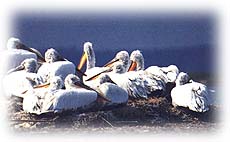 The hatchlings are born naked but are covered with white feathers in one-month time. Until the age of two and a half months they depend totally on their parents.
The hatchlings are born naked but are covered with white feathers in one-month time. Until the age of two and a half months they depend totally on their parents.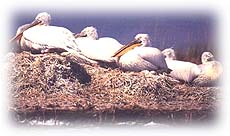 The major hazard threatening Dalmatian pelicans is human disturbance either deliberate, from visitors stepping on breeding islets to look at them or to take pictures, or accidental during the passage of vessels. When approached by visitors, the birds jump panicky to their feet and, as they brood their eggs with their webbed feet, they crush them or throw them out of the nest. Dalmatian pelicans cannot bring the out-thrown eggs back into the nest. Even if the eggs remain intact, several couples, once disturbed, never return to their nests.
The major hazard threatening Dalmatian pelicans is human disturbance either deliberate, from visitors stepping on breeding islets to look at them or to take pictures, or accidental during the passage of vessels. When approached by visitors, the birds jump panicky to their feet and, as they brood their eggs with their webbed feet, they crush them or throw them out of the nest. Dalmatian pelicans cannot bring the out-thrown eggs back into the nest. Even if the eggs remain intact, several couples, once disturbed, never return to their nests.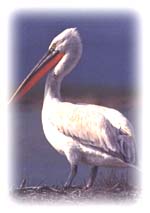 When chicks are newly-hatched, the slightest disturbance causes the parents to fly off. The chicks either die of cold or crawl panic-stricken outside the nests doomed to die from exposure to cold and rain.
When chicks are newly-hatched, the slightest disturbance causes the parents to fly off. The chicks either die of cold or crawl panic-stricken outside the nests doomed to die from exposure to cold and rain.
